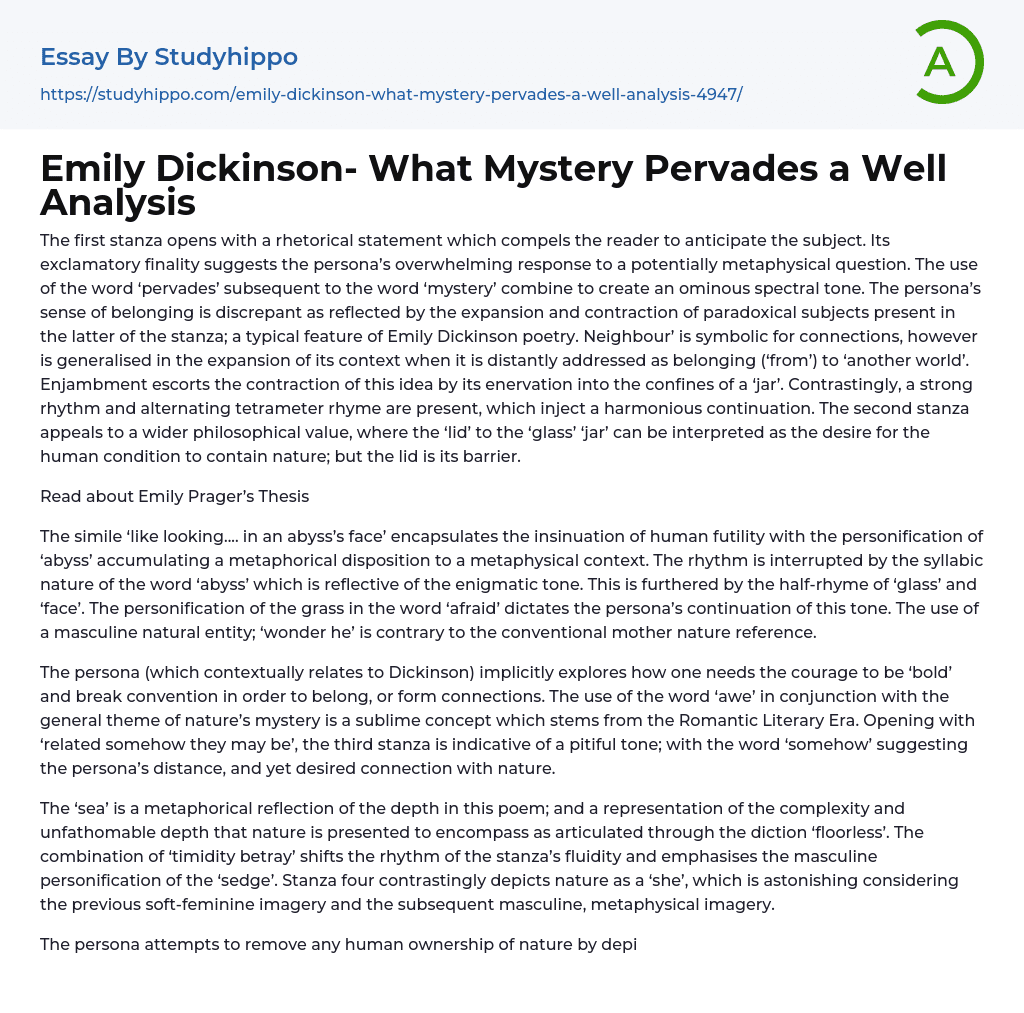

Emily Dickinson- What Mystery Pervades a Well Analysis Essay Example
The first stanza opens with a rhetorical statement which compels the reader to anticipate the subject. Its exclamatory finality suggests the persona’s overwhelming response to a potentially metaphysical question. The use of the word ‘pervades’ subsequent to the word ‘mystery’ combine to create an ominous spectral tone. The persona’s sense of belonging is discrepant as reflected by the expansion and contraction of paradoxical subjects present in the latter of the stanza; a typical feature of Emily Dickinson poetry. Neighbour’ is symbolic for connections, however is generalised in the expansion of its context when it is distantly addressed as belonging (‘from’) to ‘another world’. Enjambment escorts the contraction of this idea by its enervation into the confines of a ‘jar’. Contrastingly, a strong rhythm and alternating tetrameter rhyme are present, which inject a harmonious continuation. The second stanza appeals to a wider
...philosophical value, where the ‘lid’ to the ‘glass’ ‘jar’ can be interpreted as the desire for the human condition to contain nature; but the lid is its barrier.
Read about Emily Prager’s Thesis
The simile ‘like looking.... in an abyss’s face’ encapsulates the insinuation of human futility with the personification of ‘abyss’ accumulating a metaphorical disposition to a metaphysical context. The rhythm is interrupted by the syllabic nature of the word ‘abyss’ which is reflective of the enigmatic tone. This is furthered by the half-rhyme of ‘glass’ and ‘face’. The personification of the grass in the word ‘afraid’ dictates the persona’s continuation of this tone. The use of a masculine natural entity; ‘wonder he’ is contrary to the conventional mother nature reference.
The persona (which contextually relates to Dickinson) implicitly explores how one needs the courage to be
‘bold’ and break convention in order to belong, or form connections. The use of the word ‘awe’ in conjunction with the general theme of nature’s mystery is a sublime concept which stems from the Romantic Literary Era. Opening with ‘related somehow they may be’, the third stanza is indicative of a pitiful tone; with the word ‘somehow’ suggesting the persona’s distance, and yet desired connection with nature.
The ‘sea’ is a metaphorical reflection of the depth in this poem; and a representation of the complexity and unfathomable depth that nature is presented to encompass as articulated through the diction ‘floorless’. The combination of ‘timidity betray’ shifts the rhythm of the stanza’s fluidity and emphasises the masculine personification of the ‘sedge’. Stanza four contrastingly depicts nature as a ‘she’, which is astonishing considering the previous soft-feminine imagery and the subsequent masculine, metaphysical imagery.
The persona attempts to remove any human ownership of nature by depicting it as both genders; a clear distinction of nature’s authority over the human condition. Imagery of the ‘haunted house’ and ‘ghosts’ adopt a gothic tone, associating the metaphysical connotations of this poem to the Enlightenment Period, where the prevailing focus was maintained on ‘simplifying’ the supernatural into scientific explanations.
This stanza represents a fluid movement between the natural world and the metaphysical world. The last stanza provides a philosophical summation to the persona’s understanding of belonging; and its inner complexities in an individuals own comprehension and association with nature. The persona conveys an acceptance of the mystery of nature through the negative capabilities of the line ‘that those who know her know her less the nearer her they get’.
This indicates the complexity of nature
in direct contrast to the futility of the human condition. This paradoxical stanza also contains a feminist perspective whereby nature is an allegorical metaphor for women. Although a generalised perspective, men claim complete comprehension of the nature of women but however, do not and can not contain women to the boundaries of their own judgement (the ‘jar’), as evidenced by the patriarchal context Emily Dickinson wrote in.
- Oxygen essays
- Atmosphere essays
- Coral Reef essays
- Desert essays
- Earth essays
- Ocean essays
- Lake essays
- Sea essays
- Biodiversity essays
- Natural Environment essays
- Forest essays
- Soil essays
- Water essays
- Rainbow essays
- Ecosystem essays
- Volcano essays
- Wind essays
- Forestry essays
- Bottled Water essays
- Aldous Huxley essays
- Alice Walker essays
- Amy tan essays
- Anne Bradstreet essays
- Anton Chekhov essays
- Arthur Miller essays
- Augustine essays
- Bertolt Brecht essays
- Booker T Washington essays
- Carol ann duffy essays
- Charles Dickens essays
- Charlotte Perkins Gilman essays
- Chinua Achebe essays
- Christina Rossetti essays
- Consider The Lobster essays
- Edgar Allan Poe essays
- Elizabeth Bishop essays
- Emily Dickinson essays
- Ernest Hemingway essays
- F. Scott Fitzgerald essays
- George Orwell essays
- Harper Lee essays
- Homer essays
- James Baldwin essays
- Jane Austen essays
- John Donne essays
- John Steinbeck essays
- Kate Chopin essays
- Kurt Vonnegut essays
- Langston Hughes essays
- Leonardo Da Vinci essays



